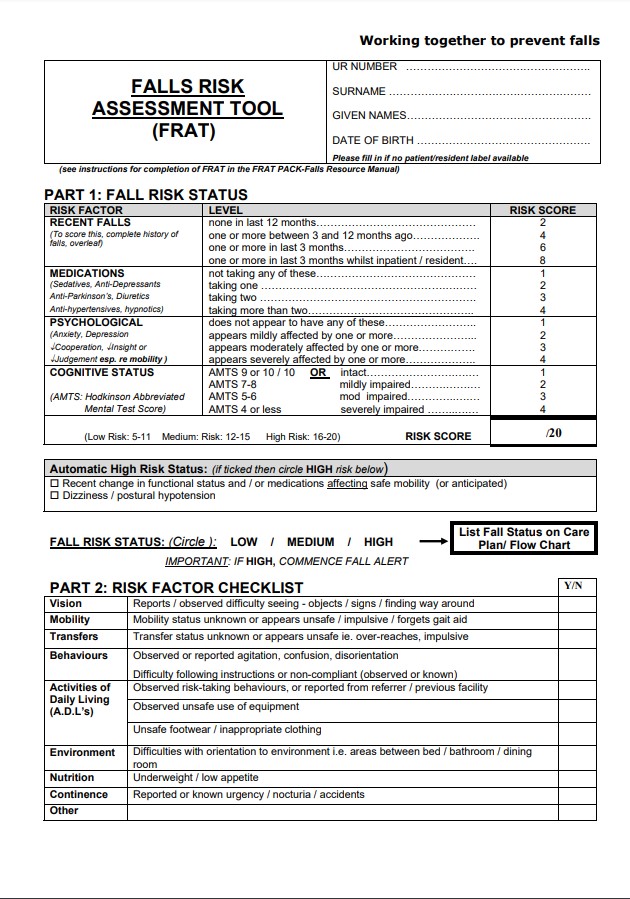The 5-Second Trick For Dementia Fall Risk
The 5-Second Trick For Dementia Fall Risk
Blog Article
Some Ideas on Dementia Fall Risk You Need To Know
Table of ContentsThe smart Trick of Dementia Fall Risk That Nobody is DiscussingThe Ultimate Guide To Dementia Fall RiskSome Known Incorrect Statements About Dementia Fall Risk About Dementia Fall RiskSome Known Factual Statements About Dementia Fall Risk
However, based on symptoms and signs, such as proof of head injury or a new focal neurologic deficit, calculated tomography or MRI of the brain may be suggested - Dementia Fall Risk. An analysis for reasons for syncope must be performed just if there is solid uncertainty, as when it comes to frequent, inexplicable falls
Doctor use a loss threat analysis to recognize your risk variables for dropping and make practical referrals. Some individuals attempt to minimize their autumn risk by limiting their activity or making every effort to be extra careful. But these sympathetic habits aren't sufficient. A loss danger evaluation is essential due to the fact that understanding which variables boost your possibilities of dropping assists you: Minimize your threat of falling or hurting yourself.
Optimize your ability to relocate and be energetic. Keep a healthy, independent life. All adults 65 years and older ought to have an initial loss danger screening. Your doctor could ask you whether you: Feeling unstable when standing or strolling. Have dropped in the past year. Stress over dropping. If you respond to yes to any one of these inquiries, your doctor will recommend an added, much more thorough evaluation.
Indicators on Dementia Fall Risk You Should Know

, and objectives specifically customized to clients that are at danger for falls. A is specified as an occasion that results in a person coming to rest inadvertently on the ground or flooring or other lower degree (THAT, 2021).
Dropping is the 2nd leading cause of fatality from unintended injuries internationally. It is approximated that loss fatality prices in the U.S
Dementia Fall Risk - Truths
If this price continues, the CDC prepares for seven fall fatalities every hour by 2030.
Each year, over 800,000 people are hospitalized because of falls. Nurses play a major function in avoiding drops for their clients through education and learning, examining autumn risk, producing much safer environments, and supplying interventions in avoiding injuries from falls.
Autumns are due to useful source several factors, and an all natural technique to the individual and setting is vital. Expect a person is considered at high danger for falls after the testing.
10 Simple Techniques For Dementia Fall Risk
A needs utilizing a validated device that scientists have analyzed to be beneficial in naming the reasons for falls in an individual. As a person's health and circumstances modification, reassessment is needed. The degree of loss risk can be determined making use of the evaluation of innate and external elements. Criterion assessment devices can likewise be used (talked about below).
Individuals are more likely to drop again if they have actually maintained one or more falls in click here for more the previous 6 months. The older populace is at enhanced danger of fall-related readmissions based on a study identifying the aspects anticipating of repeat drops linked outcomes (Prabhakaran et al., 2020).
Furthermore, confusion and damaged judgment enhance the patient's possibility of dropping. The capacity of individuals to shield themselves from drops is affected by such factors as age and growth. Older people with weak muscular tissues are extra likely to fall than those who preserve muscular tissue stamina, flexibility, and endurance. These adjustments consist of decreased visual feature, damaged see this here shade understanding, modification in center of mass, unsteady gait, reduced muscle strength, reduced endurance, altered depth assumption, and delayed action and response times.
Facts About Dementia Fall Risk Uncovered
Less comparison sensitivity was fairly linked with both increased rates of drops and various other injuries, while lowered aesthetic acuity was just related to increased fall rate (Wood et al., 2011). Sensory assumption of environmental stimuli is vital to safety and security. Vision and listening to problems restriction the person's ability to regard hazards in the surroundings.
Older grownups that have poor equilibrium or difficulty walking are more most likely to drop., or various other medical problems and therapies., and use of psychotropic drugs (Stanmore et al., 2013).
Report this page